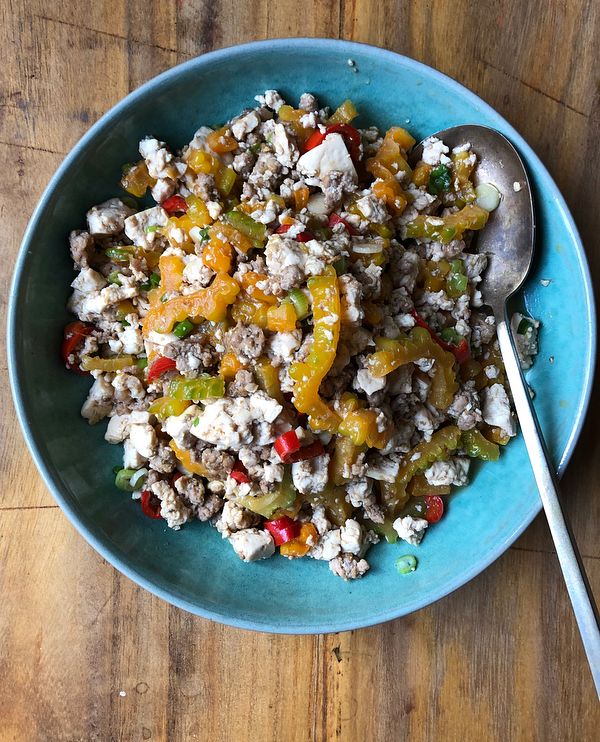
I didn’t grow up with bumpy bitter melon but over the years, I’ve learned to appreciate its weird beauty, unusual flavor and crisp-tender texture. A Hmong farmer taught me how to select them (round bumpy ones are less bitter than the spiky dinosaur like ones; green is more bitter than ripe white or yellow fruits). Elizabeth Andoh, a Japanese food authority, author and teacher based in Tokyo, pointed me to this Okinawan bitter melon, tofu, and pork scramble when I was working on my book, Asian Tofu.
A grouping of small islands off the southern coast of Japan, Okinawa is prefecture renowned for longevity. It’s been destined a “Blue Zone” by studies on healthy aging and long-life expectancies. An easygoing island environment may be the key to Okinawan longevity, but some say that it is the Okinawan diet, which includes a lot of tofu and fresh vegetables, like bitter melon, which is loaded with health benefits. I’ve read that it’s great for a whole host of things, such as diabetes, cough, and stomach problems. There are bitter melon tea packets too. If you’re into food as medicine or just trying a new vegetable, check out bitter melon.
Despite bitter melon looking like an alien, it's a familiar vegetable to many people. The two kinds -- Momordica charantia (balsam pear) and Momordica balsamina (balsam apple) grow as vines. They are native to Africa, India, and Southeast Asia, and arrived in Europe in the 16th century and came to the Americas and Caribbean in the 17th century. The squat balsam apple is inedible, according to this botanical article. What we commonly eat as bitter melon is the balsam pear -- Momordica charantia.
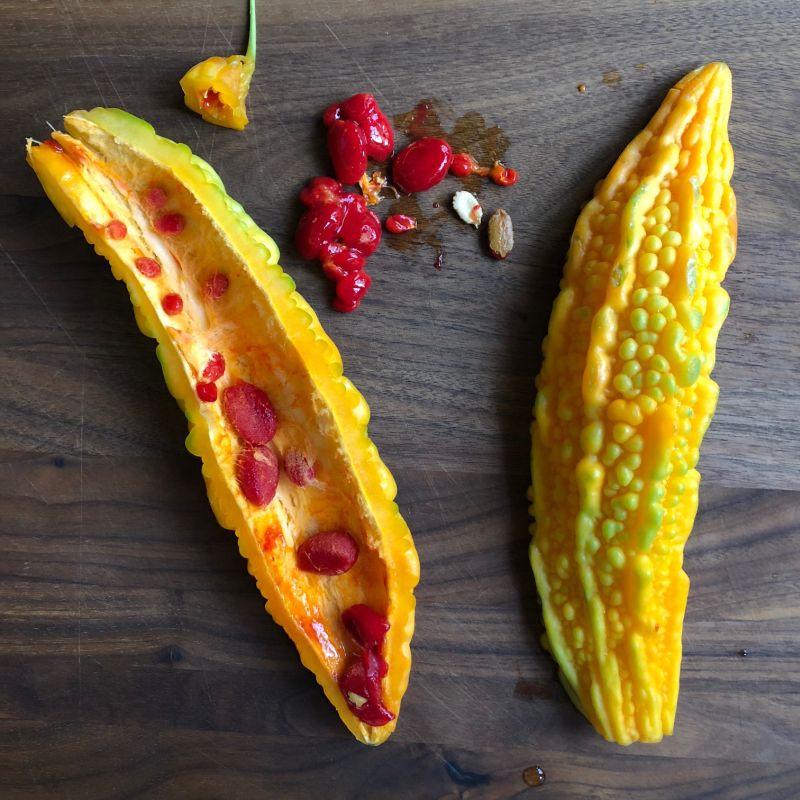
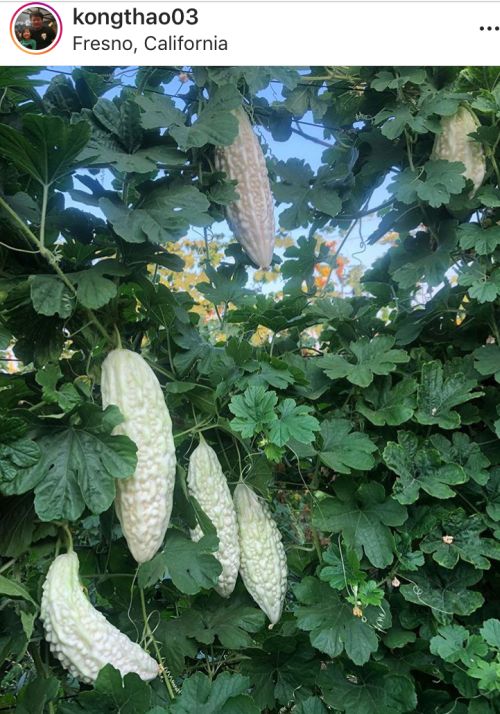
Bitter melon (goya in Japanese) is super popular in Okinawa, and Elizabeth said that this bitter melon, tofu, and pork scramble embodied everyday eating on the island. When I dug a little deeper into the dish, called goya champuru, I found that some cooks like to use Spam or bacon, a practice that reflects the Western foodways introduced during the American occupation in World War II. I like fatty ground pork. Regardless of the pork source, the richness of the meat, along with the plushness of the tofu, offset the bitterness of the melon. In other words, this is a combination for folks new to bitter melon, or don’t like overly bitter flavors. It’s a bitter melon gateway dish.
Called muop dang or kho qua in Vietnamese, bitter melon is a vegetable that my mom didn’t prepare much. We were a family of picky eaters and my mom was not into making different foods for different taste preferences. I tried bitter melon in college but it was way too bitter. But once I learned to select them and to release some of vegetable’s bitterness, it was no longer an off-putting vegetable. (Note that in Vietnam, gac fruit that is used to make a reddish-orange sticky rice, is a member of the Momordica family; it's Momordica cochinchinensis so it's not the same as bitter melon, though.)
How to Reduce Bitterness in Bitter Melon
Less mature (green) bitter melon will be crisp whereas the more mature (white or yellow) bitter melon will be a little softer. The former is much more bitter than the latter, regardless of variety. Choose your vegetable wisely. No soft spots!
Once halved, cored and sliced, bitter melon reveals it beautiful profile. I take a 2-step approach to reducing the bitterness – first soak the sliced bitter melon in water. Then, if needed, salt the slices. Bitter melon is a member of the cucumber family so you can treat it like one. I’ve seen bitter melon salads but haven’t progressed to them, yet!
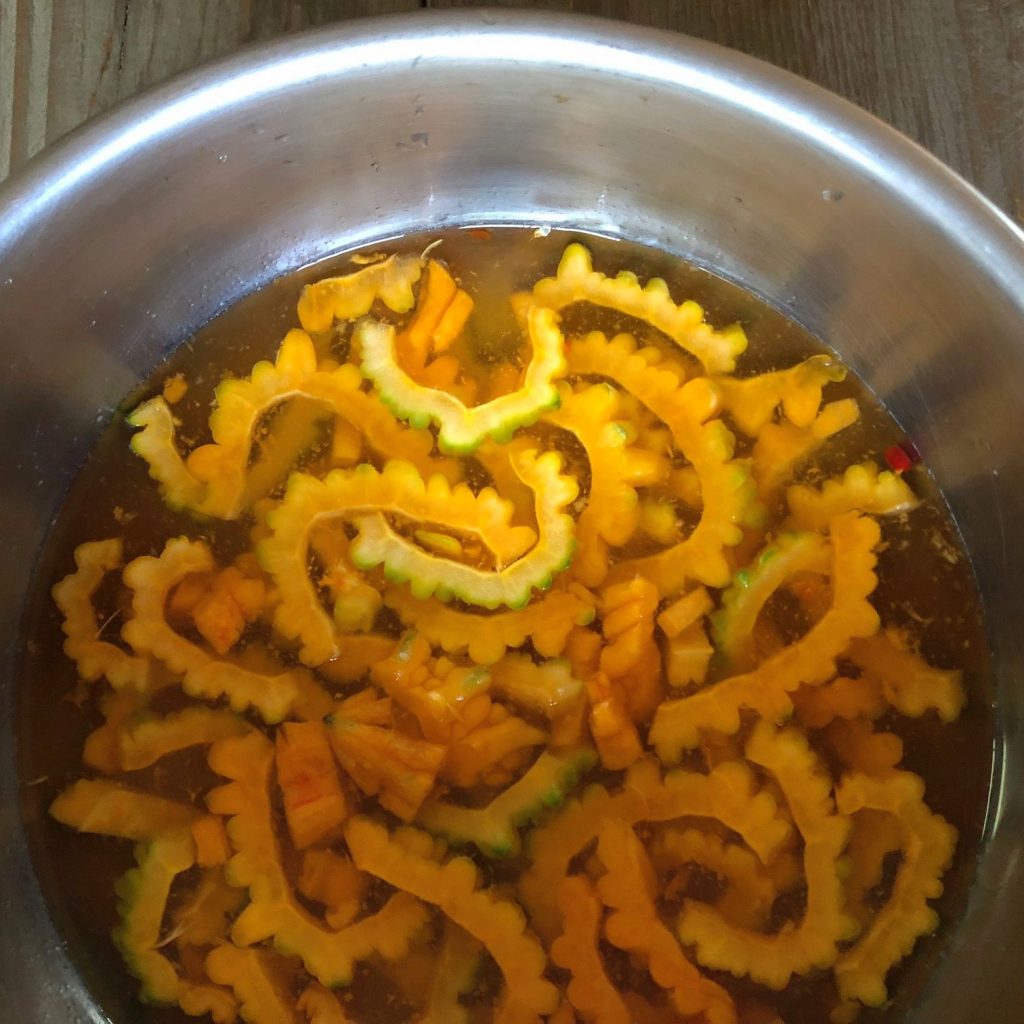
In Vietnamese, bitter melon is called mướp đắng or khổ qua. It’s often stuffed and served in broth, or stir-fried with eggs into a scramble. I like the Okinawan bitter melon, tofu and pork scramble simply because there’s more stuff (tofu and pork) to temper the bitterness. I’m a bitter melon wimp.
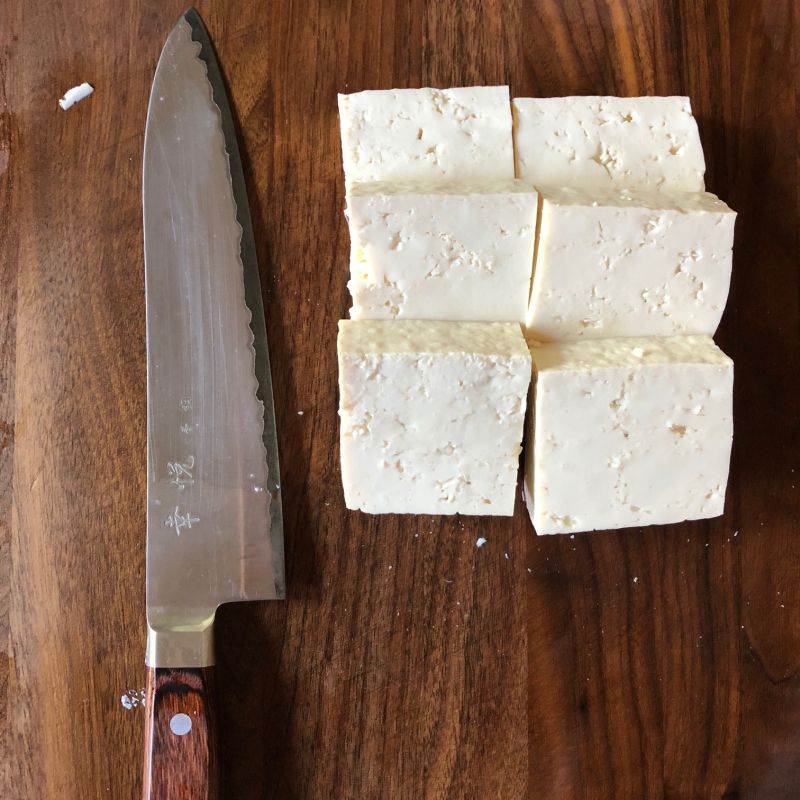
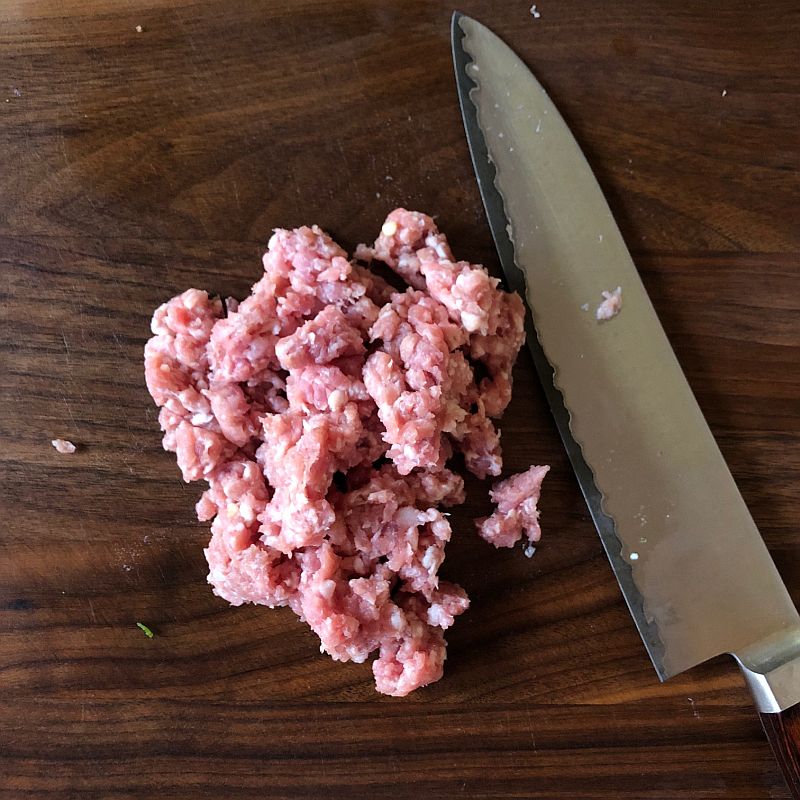
Also, the addition of a little stock lends umami and complexity. Dashi works wonders, even in such a small quantity; you can use instant dashi, if you like. If dashi isn’t available, use another kind of stock or broth.
So give this bitter melon, tofu and pork scramble a try. Bitter isn’t so bad! Maybe you’ll like it and start on an Okinawan-style long life!
Okinawan Bitter Melon, Tofu, and Pork Scramble
Yield 4 servings
If you elect to use Spam or bacon, cut them into small pieces and fry them to render fat and flavor for the dish; cut back on the sesame oil. If your bitter melon is big, add an egg to the scramble and increase the seasonings a little.
Ingredients
- 1 small to medium bitter melon (6 to 8 ounces)
- About ½ teaspoon fine sea salt
- 14 to 16 ounces medium-firm or firm tofu
- 1 ½ tablespoons toasted sesame oil
- 3 to 4 ounces ground pork, fattier kind preferred, roughly chopped to loosen
- 1 medium-hot chile, such as Fresno or Jalapeno, halved lengthwise then thinly cut crosswise
- 1 tablespoon sake
- 1 ½ tablespoons stock (dashi, chicken, or vegetable)
- 1 tablespoon Japanese or Korean soy sauce
- 1 green onion, green and white parts, thinly sliced
- Japanese ground red chile (ichimi togarashi), optional
Instructions
- Trim the ends and then split each bitter melon half lengthwise. Use a spoon to scoop out the seeds and spongy inside. Discard these. Slice each half on the diagonal into longish thin pieces.
- Put the bitter melon into a bowl and add water to cover. Gently massage until the water turns opaque; this releases some of the bitterness. Drain and transfer to a bowl. Taste and if the bitter melon is still too bitter for your taste, toss with ¼ teaspoon of the salt. Set aside for 10 minutes. More bitterness will release in the liquid that will pool in the bowl. Pour off the liquid, rinse, and set aside to drain.
- Meanwhile, cut the tofu into 2- to 3-inch squares, each about 1 inch thick. Drain the tofu for about 5 minutes atop a non-terry dishtowel or double layer of paper towels set on a plate. Put another towel on top and gently press to expel some moisture. Cut each piece of tofu into 1-inch chunks.
- Heat 1 ½ teaspoons of the sesame oil in a wok or large skillet over high heat. Add the pork, poking and mashing it into small pieces. Sprinkle in the remaining ¼ teaspoon salt and stir-fry for about 1 minute, until the pork is no longer pink. Add the bitter melon, chile, and sake. Continue stir-frying for 1 minute, until the bitter melon has just started to soften. Add the tofu, gently mashing and stirring to crumble into irregular chunks.
- Add the remaining 1 ½ teaspoons sesame oil, then cook for about 2 minutes, stirring, to heat through. Add the dashi stock and soy sauce and cook for 1 minute to allow the tofu to absorb the liquid seasonings and soften. Turn off the heat. Season with extra salt, if needed. Sprinkle in the green onion, stir to distribute, then transfer to a plate. Offer the ground red chile to guests who want it.
Notes
This recipe is based on one in my book, Asian Tofu (2012, Ten Speed Press).
Courses main
Cuisine japanese













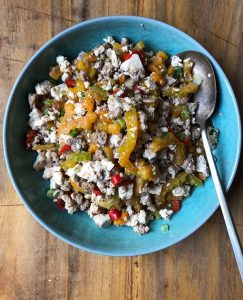




Elaine says
In Japanese "goya champuru," there's usually egg scrambled into there too. And lots of variations: with Spam, with somen noodles, with fu (gluten) and so on.
Andrea Nguyen says
Yes, you can add egg but I didn't see the need for it here. Thanks for the extra insights!
Emma Warner says
I love bitter melon! Your lovely article is a reminder to start making this again. A friend of mine had lived in Okinawa for a while, and he introduced me to goya champuru, and I really grew to like it.
Andrea Nguyen says
How do you prepare your version of goya champuru?
Kristine says
Had a bad history w/bitter melon, which I now know was due to poor-quality veg. Probably came to my local Asian market 2000 miles from the coast. Encouraged by your recipe, I bought some fresh ones from the Laotian lady at my favorite Minneapolis farmers' market. Wow! They're really interesting! I liked this recipe & also made a nice soup with pork, fish sauce, & a load of fresh Laotian herbs.
For people who haven't tried this, I'd say the bitterness is about the same as a medium-roast black coffee. It adds depth as well as a nice texture. Freshness makes all the difference!
Andrea Nguyen says
Wow, Kristine! I'm so happy that you gave bitter melon another try! And, the comparison to black coffee is absolutely brilliant. Thank you!